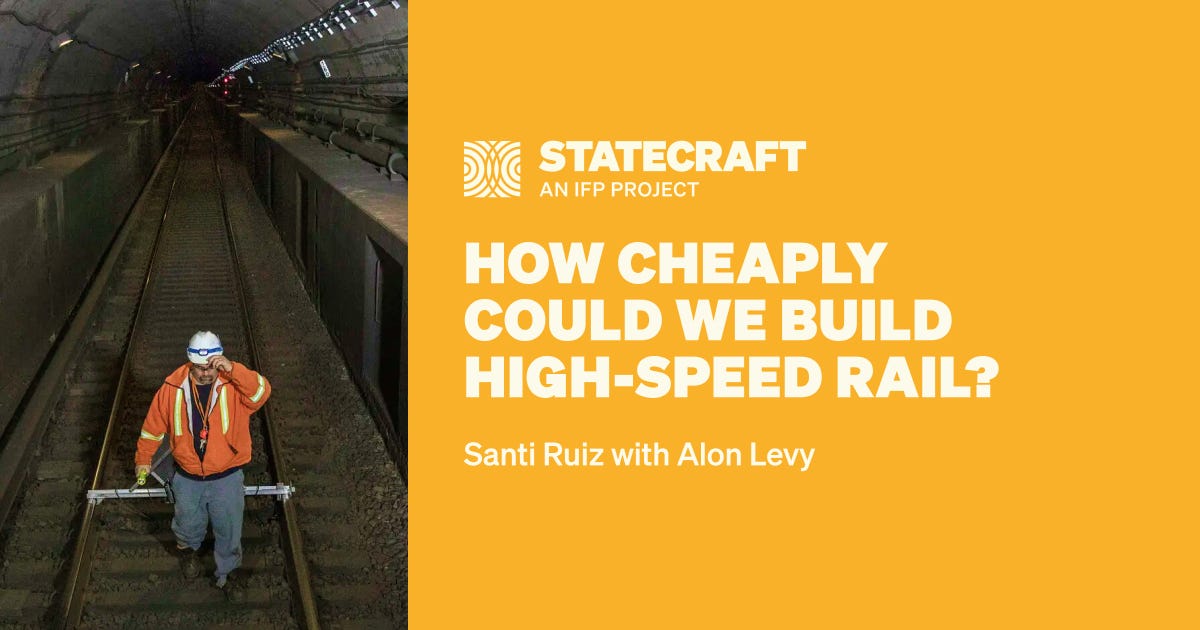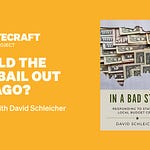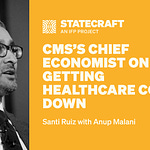At the end of April, the Transit Costs Project released a report: it’s called How to Build High-Speed Rail on the Northeast Corridor. As the name suggests, the authors of the report had a simple goal: the stretch of the US from DC and Baltimore through Philadelphia to New York and up to Boston, the densest stretch of the country. It’s an ideal location for high-speed rail. How could you actually build it — trains that get you from DC to NYC in two hours, or NYC to Boston in two hours — without breaking the bank?
That last part is pretty important. The authors think you could do it for under $20 billion dollars. That’s a lot of money, but it’s about five times less than the budget Amtrak says it would require. What’s the difference? How is it that when Amtrak gets asked to price out high-speed rail, it gives a quote that much higher?
We brought in Alon Levy, transit guru and the lead author of the report, to answer the question, and to explain a bunch of transit facts to a layman like me. Is this project actually technically feasible? And, if it is, could it actually work politically?
We discuss:
How to cut time off the Northeast Corridor
Operations coordination as a time-saver
The move away from the Mad Men commuter
Was our episode on the Green Line extension wrong?
I’m excited for this conversation, largely because although I'm not really a transit nerd, I enjoyed this report from you and your colleagues at the Transit Costs Project. But it's not really written for people like me. I'm hoping we can translate it for a more general audience.
The report was pretty technical. We wrote the original Transit Costs Project report about the construction cost of various urban rail megaprojects. So we were comparing New York and Boston projects with a selection of projects elsewhere: Italian projects, some Istanbul subway and commuter rail tunnels, the Stockholm subway extension, and so on.
Essentially the next step for me was to look at how you would actually do it correctly in the US, instead of talking about other people's failures. That means that the report on the one hand has to go into broad things, like coordination between different agencies and best practices. But also it needs to get into technical things: what speed a train can go on a specific curve of a specific radius at a specific location. That’s the mood whiplash in the report, between very high-level and very low-level.
I think you guys pulled it off very well. Let's get into it — I'll read a passage from the intro:
“Our proposal's goal is to establish a high-speed rail system on the Northeast Corridor between Boston and Washington. As the Corridor is also used by commuter trains most of the way… the proposal also includes commuter rail modernization [speeding up trains], regularizing service frequency, and… the aim is to use already committed large spending programs to redesign service.”
As a result, you think we could get high-speed rail that brings both the Boston–New York City trip and the New York City–Washington trip under two hours. You'd cut more than a third of the time off both those trips.
And here’s the kicker: you argue that the infrastructure program would total about $12.5 billion, and the new train sets would be under $5 billion. You're looking at a $17–18 billion project. I know that's a big sticker price in the abstract, but it's six to eight times cheaper than the proposals from Amtrak for this same idea. That’s my first question: Why so cheap?
First of all, that $18 billion is on top of money that has already been committed. There are some big-ticket tunnels that are already being built. One of the things that people were watching with the election was if the new administration was going to try to cancel the Gateway Tunnel, but they seem to have no interest in doing so. Transportation Secretary Sean Duffy talks about how there’s a lot of crime on the New York City subway, and how liberals want people to ride public transportation more and to drive less, but I have not seen any attacks on these pre-existing projects. So, as far as I’m concerned, they’re done deals.
The second thing is that along the length of the Northeast Corridor, this investment is not all that small. It’s still less than building a completely new greenfield line. With the Northeast Corridor, most of the line pre-exists; you would not need to build anything de novo. The total investment that we’re prescribing in Massachusetts, Rhode Island, New Jersey, Pennsylvania, Delaware, and most of Maryland is essentially something called a track-laying machine.
The Northeast Corridor has this problem: Let’s say that you have a line with a top speed of 125 mph, and the line has six very sharp curves that limit the trains to 80 mph. If those six curves are all within a mile of each other, there’s one point in the middle of the line where you have six 80 mph curves. That couple-mile stretch is 80 mph, while the rest of the line is 125. Now, what happens if these curves are evenly spaced along the line?
You have a way longer commute, right?
Yes. If you have to decelerate to 80 mph and back five times, that’s a lot slower. That’s the problem in the Northeast Corridor: there are faster and slower segments. Massachusetts is faster. Rhode Island is mostly fast. Connecticut is slow. If you have a line that’s slow because you have these restrictions in otherwise fast territory, then you fix them, and you’ve fixed the entire line. The line looks slow, but the amount of work you need to fix it is not that much.
Most of the reason the Northeast Corridor is slow is because of the sharp curves. There are other fixes that can be done, but the difficult stuff is fixing the sharp curves. The area with the sharpest curves is between New Haven and southern Rhode Island. The curves essentially start widening around the point where you cross between Connecticut and Rhode Island, and shortly thereafter, in Rhode Island, it transitions into the fastest part of the Corridor.
In southeast Connecticut, the curves are sharp, and there’s no way to fix any of them. This is also the lowest-density part of the entire Northeast: I-95, for example, only has four lanes there, while the rest of the way, it has at least six. I-95 there happens to be rather straight, so you can build a bypass there. The cost of that bypass is pretty substantial, but that’s still only about one-sixth of the corridor. You fix that, and I’m not saying you’ve fixed everything, but you’ve saved half an hour.
Your proposal is not the cheapest possible high-speed rail line, but I want to put it in context here. In 2021, there was a big proposal rolled out by the Northeast Corridor Commission, which was a consortium of states, transit providers, New Jersey Transit, Amtrak, and federal transportation agencies. Everybody got in on this big Connect Northeast Corridor (Connect NEC) plan, and the top line number was $117 billion, seven times your proposal. And this is in 2021 dollars.
They didn’t think that they could do Boston to New York and New York to DC in two hours each, either. There are two different reasons for their high price tags. The first reason is that they included a lot of things that are just plain stupid.
For example, theirs involved a lot of work on Penn Station in New York. Some of it is the Gateway Project, so that money is committed already, but they think that they need a lot beyond the tunnel. They have turned Gateway into a $40 or $50 billion project. I’m not going to nitpick the Gateway spending, although I’m pretty sure it could be done for much cheaper, but they think they need another $7 billion to rebuild Penn Station, and another $16 billion to add more tracks.
And you don’t think that’s necessary.
No. We ran some simulations on the tracks, and it turns out that the Penn Station that currently exists, is good enough — with one asterisk — even if you ran twice as much service. You can’t do that right now because, between New Jersey and New York Station, there is one tunnel. It has two tracks, one in each direction. They run 24–25 trains per hour at the peak. This is more or less the best that can be done on this kind of infrastructure.1
For about 30 years, they have wanted to build a second pair of tracks. This used to be called ARC, or Access to the Region’s Core. It was funded, but Governor Chris Christie [of New Jersey] canceled it on the grounds that there could be cost overruns that the state would be on the hook for. Then Amtrak took over the project and renamed it Gateway. The cost increased subsequently, and instead of two tracks, they are going to have four tracks. They think they need 48 trains per hour at rush hour into Penn Station, which actually makes sense if you’re mildly optimistic about return-to-work in New York. New Jersey is building a lot of housing by Northeastern American standards, and the demand there is mostly commuters into New York City, so in the medium term, ridership will increase. It’s a sensible project to build.
Unfortunately, they think Penn Station itself can’t handle the doubled frequency and would need a lot of additional work. Amtrak thinks that it needs to add more tracks by condemning an entire Midtown Manhattan block south of Penn Station called Block 780. They’re not sure how many tracks: I’ve seen between 7 and 12.
To be clear, the number of additional tracks they need is 0, essentially because they’re very bad at operations.
Well, let’s talk about operations. You say one way to drive down the cost of high-speed rail is just better-coordinated operations for all the trains in the Corridor. The idea is that often fast trains are waiting for slow trains, and in other places, for procedural reasons, every train has to move at the speed of the slowest train that moves on that segment.
What’s the philosophical difference between how you and the rail managers currently approach the Corridor?
The philosophical difference is coordinating infrastructure and operations. Often you also coordinate which trainsets you’re going to buy. This is why the proposal combines policy recommendations with extremely low-level work, including timetables to a precision of less than a minute. The point of infrastructure is to enable a service. Unless you are a very specific kind of infrastructure nerd, when you ride a train, you don’t care about the top speed, you don’t care about the infrastructure. You care about the timetable. The total trip time matters. Nobody rides a TGV to admire all the bridges they built on the Rhone.
I think some people do!
I doubt it. I suspect that the train goes too fast to be a good vantage point.
But as I said, you need 48 trains per hour worth of capacity between New Jersey or Manhattan. You need to start with things like the throughput you need, how much you need to run on each branch, when each branch runs, how they fit together. This constrains so much of your planning, because you need the rail junctions to be set up so that the trains don’t run into each other. You need to set up the interlockings at the major train stations in the same way. When you have fast and slow trains in the same corridor, you need to write timetables so that the fast trains will not be unduly delayed.
This all needs to happen before you commit to any infrastructure. The problem is that Connect NEC plans (Connect 2035, 2037) are not following that philosophy. They are following another philosophy: Each agency hates the other agencies. Amtrak and the commuter rail agencies have a mutually abusive relationship. There’s a lot of abuse from Amtrak to various commuter rail operators, and a lot of abuse by certain commuter rail operators, especially Metro North and Connecticut DOT against Amtrak. If you ask each agency what they want, they’ll say, “To get the others out of our hair.” They often want additional tracks that are not necessary if you just write a timetable.
To be clear, they want extra tracks so that they don’t have to interact with each other?
Exactly. And this is why Amtrak, the commuter railways, and the Regional Plan Association keep saying that the only way to have high-speed rail in the Northeast Corridor is to have an entirely separate right of way for Amtrak, concluding with its own dedicated pair of tunnels to Penn Station in addition to Gateway.
They’re talking about six tracks, plus two tracks from Penn Station to Queens and the Bronx, with even more urban tunneling. The point is that you don’t need any of that. Compromising a little on speed, the trip times I’m promising are a bit less than four hours from Boston to Washington. That’s roughly 180 kilometers an hour [~110 mph]. To be clear, this would be the slowest high-speed line in France, Spain, or Japan, let alone China. It would probably be even with the fastest in Germany and South Korea. It’s not Chinese speed. For example, Rep Moulton was talking about high-speed rail a couple of months ago, and said, “This is America. We need to be faster. Why not go 200, 250 mph?” He was talking about cranking up the top speed. When we were coming up with this report, we were constantly trying to identify how much time a project would save, and often we’d say, “This curve fix will speed up the trains by 20 seconds, but for way too much hassle and money.” The additional minutes might be too expensive. Twenty seconds don’t have an infinite worth.
So there's coordination between infrastructure and operations, there's coordination between interstate and committee planning, and there's some kind of coordination between system maintenance and additional construction. These are two separate things that unfortunately are being bundled together in America, but not coordinated, if that makes sense to you.
You're going to have to explain that.
Maintenance is a recurring expense. It’s treated as a capital expense because, if I’m deciding not to pay the train drivers for the next three months, then I’m not gonna have trains running. The train drivers don’t work for free. But if I decide not to do maintenance for the next three months, then I could do maintenance in the subsequent three months. I can defer it: it’ll cost me more in the long run, but sometimes it’s worthwhile to take this cost.
There is a temptation to defer maintenance, especially the long-term maintenance issues, but if you defer maintenance in the short run, in the long run, your system collapses. There was a solution to this in the ‘80s, which was called State of Good Repair on the New York City subway, where they came up with these five-year capital plans that characterize how subway investment is done today.
Up until then, operations and maintenance were funded as one thing, and outside capital infusions could go towards expansion. For example, they constantly wanted to build the Second Avenue Subway in the ‘50s, ‘60s, and ‘70s. In the ‘80s, because the system was collapsing, one-third of it was under slow restrictions, and by slow restrictions I mean you were going 10, 15 mph. The trains broke down every 6,200 miles in 1982.
That seems like a lot of breaking down.
Yes, after they fixed the system in the 2010s the breakdown rate was less than one in 100,000 miles. You could do better — there are places that scratch seven digits. Six digits means you see a breakdown on your own train once in a generation, which means you're stuck behind a train that's broken down maybe once a year. At one every 6,000 miles, you see a breakdown probably once a year, and you get stuck behind a broken-down train every week or two.
New York decided to do long-term capital spending on renewal and maintenance, and it worked. Unfortunately, after it worked, everyone else copied that, and in very different circumstances, essentially reducing maintenance to a capital mega-project.
Amtrak did that in the 2000s. Amtrak President David Gunn refused to defer maintenance. At the time, it was the Bush administration, and they were trying to privatize. When you intend to privatize, you will defer maintenance to look financially good for a merger. It’s not unique to Amtrak or to the US. The politicals fired him.
Then the administration changed, and the Obama administration was not interested in privatizing, but it was interested in investing in high-speed rail, which in the 2000s was viewed as this flashy thing. Amtrak cried poverty and said, “Oh look, we have this big maintenance backlog. Please give us money for State of Good Repair.” Essentially, it became a way to spend mega-project money with nothing to show for it.
What should we do with this existing system of funding, where I apply for megaproject money to do my State of Good Repair maintenance?
Outside funding, like federal funding to a state or local agency, should not go to State of Good Repair. It should go to capital spending that you can say no to. Expansion of a rail line is one example. Instead, the federal government should demand that maintenance be funded on an ongoing basis, locally or regionally.
With commuter rail, state regional rail programs like the Hartford Line in Connecticut, you want maintenance to be done in a very mechanized fashion, with track machines which go on the tracks. They do the work at the speed of a very slow walker, maybe one third of a mile every hour, because they're literally changing everything. They maybe unscrew the two rails from the cross ties, and then they replace the cross ties. They need to go at an extremely slow and methodical speed. And then you replace the rails. You replace the ties.
You can even replace the curves. Curves are always banked or “canted”: the outside rail is a little higher than the inside rail. Because you have centrifugal force pulling the train outward, you use gravity to partly countermand that force. The “cant angle” in the United States is not as aggressive as it can be.
American regulations are not different from European regulations on this, but American practice is constantly too conservative. They don't go as fast as the regulations will permit. It’s another way that you can speed things cheaply: running the trains as fast as the regulations permit, and not as fast as the accumulated practices of American railroading say that you can.
There are all these 10 or 15 mph restrictions in station throats that don't need to be there. If you're going from 10 mph to 30, it doesn’t sound flashy, but you can save four minutes on just the last mile into Grand Central on every Metro North commuter train. You can save two minutes the last mile and a bit between Back Bay and South Station in Boston. Both intercity trains into Boston, every commuter train into Boston, that goes by back bay.
I want to go back to something you said earlier. You were contrasting the aesthetic of this proposal with Representative Moulton’s proposal, who wants our top speeds to be faster than Chinese top speeds. How do you get voters to care about — and I mean this descriptively — kinda boring stuff about cant angles?
Voters are not going to care about the cant angle efficiency on a curve. They’re not going to care about approach speed. However, I do think that they will if you tell voters, “Here's the new timetable for you as commuters. It looks weird, but your commute from Westchester or Fairfield County to Manhattan will be 20 minutes faster.”
With a lot of these reports, the issue is often that there are political trade-offs. The idea of what you should be running rail service for, who you should be running it for, that ended up drifting in the middle of the 20th century.
But also, the United States is so far from the technological frontier that even the very basics of German or Swiss rail planning, like triangle planning of rolling stock/infrastructure/operations, that's not done. Just doing that would be a massive increase in everything: reliability, frequency, speed, even in passenger comfort.
The main rail technology conference in the world, it's called InnoTrans, it's in Berlin every two years. I hear things in on-the-floor interviews with vendors that people in the United States are just completely unaware of. That matters for things that are really boring, like how you rebuild the overhead catenary that provides the electricity that the trains are using.
Confession: I had to read that section twice because the first time I just could not pay attention.
This is, to be clear, boring. I am a nerd for public transportation, but not for that. I had to outsource some of the nerdery to people who are that kind of overhead wire nerds. But it’s actually important: the US is so far behind that the basic kind of catenary that exists on practically every low-speed regional line in Europe would be a major innovation at rather low cost.
The high construction cost problem is specifically in New York, but the rest of the English-speaking world is not too far behind, unfortunately: Los Angeles, San Francisco, Boston, London, Toronto, Hong Kong, Singapore, Melbourne, Sydney.
You propose the full integration of planning across seven or eight states, Amtrak, the Federal Transit Association, and the feds. If you integrated all those organizations and synthesized that work, you could get a lot of gains just from timetabling. In practice, when those organizations coordinate, what you see is the Connect 2035 project. You don't get this synthesized, efficient model. Why be optimistic that you could do this?
The problem is that Connect 2035 is a staple job. It's New Jersey Transit’s list of priorities — some of which are very good and made it into our proposal. You staple that with Metro-North’s list of priorities, a few of which are good, most of which are terrible. You staple that with the Massachusetts Bay Transit Authority’s (MBTA) wishlist, with Southeastern Pennsylvania Transit Authority (SEPTA), Amtrak, some state DOTs that are working independently of their community rail agencies because they’re not used to coordinating.
Coordination needed to be invented, and in the United States, it never was, because the railroads were used to competing against each other, and then they were used to competing against Greyhound, for example. They did not coordinate intercity bus and intercity rail service. To this day, these are competitive, rather than in any kind of combined system.
The commuter railways in the United States did not think about coordination very much because of the demographics of the rider. The commuter rail in the United States is generally designed around Don Draper and Pete Campbell from Mad Men: high-income, 9-to-5 workers who live in the suburbs, because that’s where you're expected to live as a middle-class American.
But while the Manhattan core [south of Central Park] gets more commuters as of May 2019 than in the 1960s, fewer of them arrive in peak hours than did in the ‘60s. Not a lower percentage: fewer in absolute terms. But the mentality is still 9-5.
This created a two-tier planning system where the buses were viewed as for the poor. And to this day, in Boston’s MBTA zone, apparently, they're not allowed to coordinate their commuter rail schedules with the buses. It's considered something different.
A lot of it is just needing to invent this coordination, but you don't need to invent it. It was done already. It was done mostly in Germany in the 1970s to create its modern inter-city rail network, which is not very fast. It's just much better coordinated than anywhere else, so the ridership is the same as in France per capita (and France has way faster trains).
I would also love coordination, but the current state of coordination among rail agencies is Connect 2035. In a past Statecraft episode, Jen Pahlka read this quote to me: “No suggestion for reform is more common than, ‘What we need is more coordination.’” So explain to me why coordination is not pie in the sky.
The reason this is not pie in the sky2 is that they all get their money from the same source, the source being Federal Railroad Administration (FRA) funding for the Northeast Corridor. They’re not actually competing with each other. Sure, there are competitive grants, but the FRA can indicate its priorities, and when it's important enough to the Feds, they indicate these priorities.
All of these agencies are getting their funds from the same pot of money. This is something where the FRA could be prioritizing about half of the $12.5 million in infrastructure we’re proposing. These are projects that are already on the list, like junction fixes. Some are stuck in planning, like the bypass along I-95 between New Haven and Southern Rhode Island. That is not something that I made up on the spot. This was in the Northeast Corridor's future plans in the 2010s. They ran into some NIMBYism in southeastern Connecticut, and the alignment that I drew in the report was specifically trying to mollify three complaints from the people of Old Saybrook, CT. I think what we drew addresses two of them. The third, you can’t, but there’s a limit to how much you can mollify.
But it’s not the kind of flashy thing you see when you go on a three-day junket to France to ride the TGV, or to Japan to ride the Shinkansen. You need to drill down and talk to intermediate-level people and see how the planning was done in France or Germany, what they did or didn’t do. A lot of it is just Not Invented Here Syndrome. You can get around Not Invented Here Syndrome, you can say, “Oh my God, our trains are much slower and less reliable than they are elsewhere. We need to learn even from places we are not used to learning from.” This does happen.
It requires a very large gap in capabilities to take this cultural embarrassment of having to learn from people that you're not used to learning from. But that gap exists: the trains in the Northeast Corridor are genuinely much worse than the top-line corridors in every developed country of the same scale as the Northeastern US.
How do you get buy-in from all the states required for a proposal like this? There would be a lot of construction in New Jersey, but the benefits to the state are pretty modest. You have the reverse dynamic for Pennsylvania; Philly would gain a ton from increases in speed, but it would face relatively little construction.
Under your proposal, you would have to switch trains in DC if you wanted to go from Richmond directly to New York City. Currently, it’s just one train. How do you sell that to Virginian politicians and voters?
So how do you get all those states on board? The classical political economy idea here is that every state asks for their pound of flesh. Then you end up with something closer to what you get in practice, which are the Connect 2035 or 2037 models that cost a hundred billion plus.
The answer is that every state does get their pound of flesh. For example, in New Jersey, yes, there’s extensive construction, but all of it is driven by the state. Everything that I’m proposing to be included in Jersey is three projects: it is a portal bridge south, it is Hunter Flyover, which is a flyover on the Raritan Valley line in the Northeast Corridor, and the Mid-Line Loop, an elevated project that lets local trains turn in central Jersey without mucking the track for the express trains. All of these are on the New Jersey Transit’s wishlist. I believe it applied for Bipartisan Infrastructure funding for all three of them, and it got funding for other things that it applied for. This is driven by the state; all of these are of great utility to the commuter trains in the state.
This repeats itself in every state between Massachusetts and the District of Columbia. They all get things for interstate and commuter trains. In Virginia, you are right that there is a more serious trade-off — unless they wire the line down to Richmond, they’re going to need to change trains.
Now, can they wire the line to Richmond? If Virginia says, “Sure, but we want money for electrifying and some upgrades,” absolutely. As far as I'm concerned, that needs to happen anyway for better service to Virginia.
In Virginia, it is an imposition if people have to change trains at Washington Union Station. On the other hand, the trains they are going to change to are significantly faster to New York. Obviously, different riders have different opinions on this. Probably, if you’re a very seasoned rider and you’re by yourself without luggage, you don’t care. If you're traveling as a family, you care more. If you’re an irregular rider, it’s confusing, so maybe you care more.
On average, people will take a transfer to speed a trip by 15–20 minutes. I’m promising an increase in speed that turns the Northeast Corridor into 1:56 from New York to DC. Today, it’s just under three hours if you're paying the Acela premium, and three and a half hours if you're not.
I want your thoughts on a conversation we had in this series with the former head of Massachusetts Transit, Stephanie Pollack. She came in on the Green Line Extension project in Boston, which you've written quite a lot about. You've been pretty critical of her in the past: in 2020 you described problems with Massachusetts Transit as “nothing that firing Stephanie Pollack and hiring an actually competent person wouldn't fix.” I take it that you had some criticisms of her comments on Statecraft.
Yes, I have. What she said was that you can't compare different projects because the costs in the United States are inclusive of things that are not included elsewhere, and the problem is that she’s wrong. For example, for our database for construction costs, we very dutifully included only infrastructure, not train sets. We have a different database for train sets. There is an American premium in the acquisition cost of these train sets; it's much smaller than the premium for infrastructure. Likewise, with other kinds of infrastructure, things like heavy maintenance, facilities, planning, all of that is included elsewhere.
What's the upshot here? Why does it matter?
It matters because of two things. The first is that the costs in the United States are actually comparable. The delivery is practically the same. It's just that the soft costs in the United States are excessive. I don't mean that everything is excessive, although it is. What I mean is that you take the hard costs, and in Italy or France, the planning costs on top are between 5-10%. In the United States, there might be 20% on top. Then you look at all the other soft costs, and there will be an additional 50% in the United States.
There’s just much less white collar job productivity in the United States for public sector projects. The private sector, the American white collar office sector, what people deride as “email jobs,” they’re very efficient. On top of the US public sector being inefficient, you also need to pay salaries to be competitive with an extremely efficient private sector.
If you look at, for example, how many white collar supervisors are required per blue collar worker for construction in the US, it’s consistently much more for things like the Green Line extension than it is for private sector construction projects.
So there’s this myth of apples to apples, that the United States can't be this bad, but it is. It’s just coming from people who don't know how things work in any country that doesn’t speak English natively, so they come up with really weird ideas about what is and is not included in a Swedish construction project or a German one, or a Turkish one, or an Italian one.
We talked to Pollack about her work on the Green Line extension that goes northwest out of Boston into the suburbs. Pollack came in when the project was well over budget and tried to bring the budget back down. How do you rate her performance on the Green Line extension?
First of all, her performance started with the fact that she sued people into building it, which means that the previous cost overruns are, to an extent, her fault as well, because she created a situation in which the project was considered a must-build. When you make something a must-build, you are giving everyone an excuse to lead it with their pound of flesh.
A pound of flesh is almost never actually necessary. It’s just that people won’t say yes to things, and they don't watch the budget. Not watching the budget is partly her legacy as well. I don’t want to say that she’s the main villain of the story. She isn’t. She’s one of many. The reduction in costs under Governor Baker were real, but even after the cost reduction, that would’ve been a rather expensive subway project. It was not a subway project; it was a light rail project in an existing trench they needed to widen a little bit.
This is why I'm quoting the former MBTA general manager, Frank DePaola, who said commuter rail is not mass transit. The problem is that all these decisions were bad. Again, I'm not going to make Pollack the main villain.
What annoys me about her is that she didn't say, “Yeah, we did a bad job here,” or the lessons learned not to do it again. Instead, she's defending the worst decisions, like trying to privatize decision-making further, doing these special-purpose delivery vehicles that they did under Governor Baker, where they hired experienced project managers and got things under control, and then instead of keeping them in-house for further projects that they knew they were gonna build, they let it all dissipate.
In Paris, by the way, for the 200-kilometer expansion of the metro — a bunch of driverless lines in the inner suburbs of Paris, some extensions of existing lines, and some new orbital lines — they established this special purpose delivery vehicle, but instead of letting it go to waste, as they did in Boston and London for Crossrail, they're making it a permanent institution. Once you’ve hired all these experienced project managers, engineers, planners, architects, and transport economists, what are you going to do? Let them all go, so that each of them is going to pick the few pieces that they learned and take them to a consultancy? No, you’re going to keep them, because you're going to build more.
In the case of France, they’re going to use it as a public sector consultant to help build similar things in all the other cities of France. In Boston, they could have done this. They are building more things, but they didn't make this long-term commitment.
To go back to high-speed rail, this is one of the things I’m complaining about: it’s something that requires this top-down coordination, where someone needs to say no. The FRA is capable of saying no. It’s not captive to any of the states that want something, but they’re just not used to doing it. They’re used to the idea that the federal government just staples other people’s proposals together.
Thanks. Before we close, I want to make sure I’ve got a good sense of your answer to the political challenge here. Your contention is that the power to force the coordination you want to see already exists.
Exactly. It’s just that the power is not being used because of Not Invented Here Syndrome, where the railroaders are used to having been taught certain standards that they're not going to question.
Because what are you going to do, go look at the German engineering standards? First of all, they're written in German, and second, there's this, “Oh, America is different, we can't” mentality. This also includes the understanding of how to do this coordination, which means you start with a timetable. I’ve been told by people that a plan like mine should never go down to the level of detail of timetables through the minute. But in Switzerland, when they go to a referendum on these projects, they include the timetable to the minute, because that’s important. The exact timetable — to the minute — actually has to connect. Whereas, in the United States, you come up with the big plan first, and you expect the assistants to the assistants to fill out the details.
If you got this far, you may be interested in our other installments on transit. You can find them here.
Alon: “If you've heard of places that run more trains per hour, these are not mainline trains. These are captive metros, where it's much easier for each train to substitute for another train if they all make the same stops, or maybe they have a two-way branching, and otherwise they make the same stops. That's where you can crank it up. But on a highly branched mainland system, this is more or less the best that you can do.”















